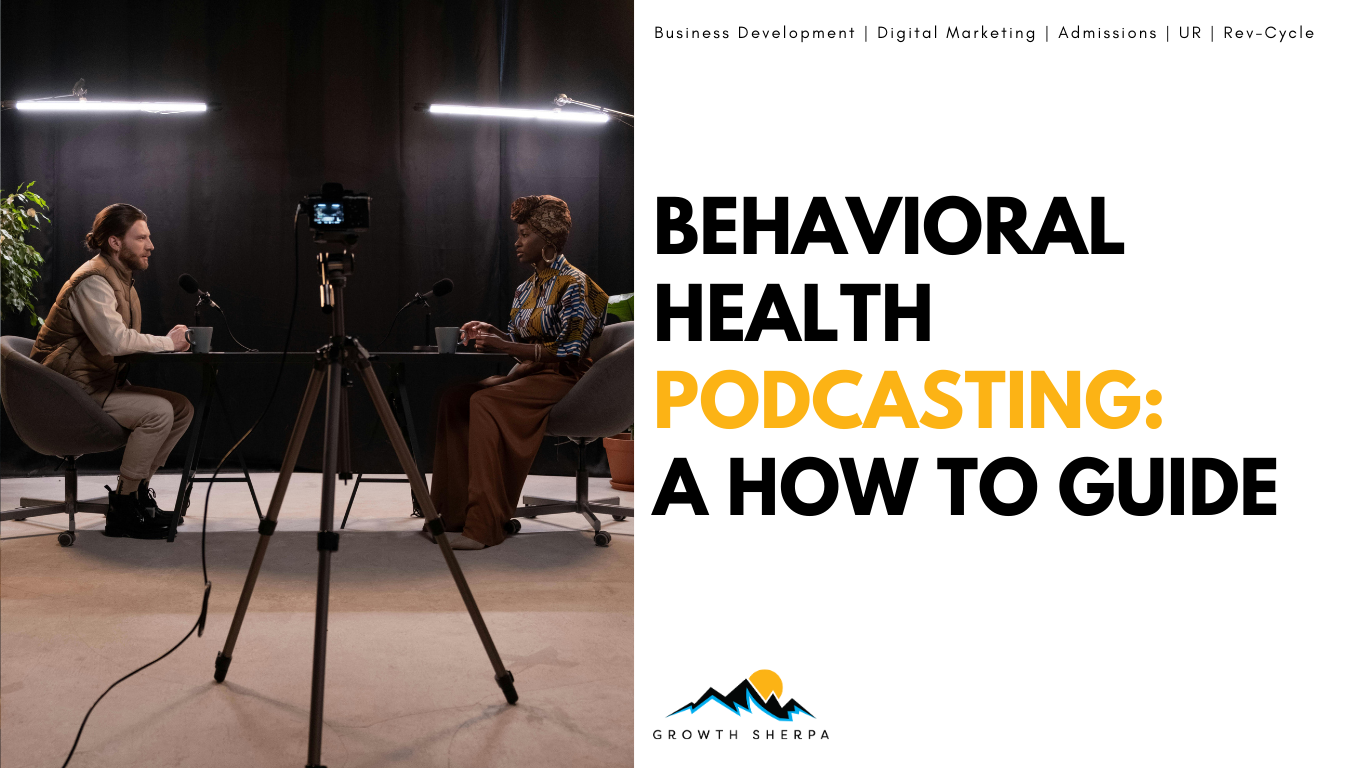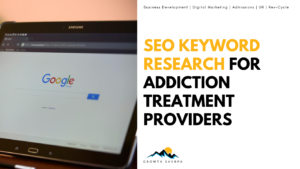In the world of behavioral health and addiction treatment, content marketing is key to educating your audience, building trust, and increasing patient referrals. One of the most impactful tools in your content marketing arsenal is podcasting. With its growing popularity, podcasting provides a unique platform to engage with a wide audience, sharing your expertise, insights, and stories in a deeply personal way.
Whether you’re a small rehab facility, a multi-facility network, or a solo therapist, podcasting allows you to connect directly with potential clients, families, and industry professionals. In this blog post, we’ll cover everything you need to know about creating a podcast for your behavioral health practice, from building your brand and developing an episode outline to using social media to grow your audience.
1. Creating a Brand for Your Podcast
Before diving into content creation, it’s crucial to establish a strong brand for your podcast. Just like any other aspect of your business, your podcast should reflect your core values and expertise.
Key elements to consider when branding your podcast:
- Podcast Name: Choose a name that is relevant, memorable, and aligns with your practice or facility’s mission. Examples could be “The Recovery Journey,” “Mental Health Conversations,” or “Breaking Through: Addiction Recovery Stories.”
- Tone and Style: Decide whether your podcast will be educational, conversational, or a mix of both. Will it focus on interviews, or will you share stories and personal insights from your team? The tone should reflect your brand’s voice—whether that’s comforting, inspirational, or informative.
- Target Audience: Are you speaking to individuals seeking help, family members of those struggling with addiction, or professionals in the field? Tailor your content to the people you want to reach, ensuring that it addresses their concerns and interests.
A well-defined brand will make your podcast stand out, build trust, and resonate with your target audience.
2. Developing the Show Outline
Once you have your brand in place, the next step is to plan your content. Every episode should have a clear structure, so your listeners know what to expect and can follow along easily.
Here’s a framework to consider when outlining your episodes:
- Introduction: Begin each episode by introducing the topic and setting expectations. This can be a quick 30-second overview of what listeners will learn or the guests you’ll feature.
- Main Content: Dive into the core subject matter. If you’re discussing a mental health topic, provide actionable insights and tips. If you’re interviewing a guest, prepare thoughtful questions to guide the conversation. Be sure to stay focused on the episode’s theme and provide valuable, relevant information.
- Call to Action: At the end of each episode, include a clear call to action (CTA). Encourage listeners to book a consultation, visit your website for more resources, or share the episode with others. This is crucial for turning listeners into potential clients or referral sources.
- Consistency: Release episodes on a regular schedule (e.g., weekly or bi-weekly) so your audience knows when to expect new content. Consistency builds listener loyalty and helps your podcast grow over time.
3. Choosing the Right Platforms for Publishing
Once you’ve recorded your podcast, it’s time to publish. Thankfully, there are numerous platforms where you can upload your episodes and distribute them to a wide audience.
Popular podcast hosting platforms:
- Libsyn: One of the oldest and most trusted hosting platforms, Libsyn offers easy distribution to all major podcast directories, including Apple Podcasts, Spotify, and Google Podcasts.
- Anchor by Spotify: This free platform offers podcast hosting and automatic distribution to major streaming services. Anchor also allows you to record and edit your podcast directly in the app.
- Buzzsprout: Another popular hosting platform, Buzzsprout makes it simple to publish and track your podcast’s performance.
Once your podcast is live, be sure to submit it to directories like Apple Podcasts, Google Podcasts, and Spotify. The more places your podcast appears, the better your chances of reaching a wider audience.
4. Utilizing Video for Enhanced Engagement
While audio is the heart of podcasting, adding video to your episodes can increase engagement and broaden your audience. Many people prefer consuming content through video, making platforms like YouTube a powerful addition to your podcast strategy.
Ways to integrate video into your podcast:
- Record video of your podcast interviews: Post the full episode or highlight clips on YouTube, Instagram, or LinkedIn. Video adds a personal touch, allowing viewers to see facial expressions and body language, which can enhance the message.
- Create short video teasers: These can be posted on social media to promote upcoming episodes or highlight key points from past episodes. For example, a 60-second clip on Instagram Reels or TikTok can generate interest and drive traffic to the full episode.
Video podcasts, or “vodcasts,” provide a multimedia experience that caters to both auditory and visual learners, expanding your reach.
5. Including Referral Partners for Extended Reach
One of the biggest benefits of podcasting is the opportunity to collaborate with others in your industry. By featuring referral partners, such as addiction treatment centers, mental health professionals, or service providers, you not only enhance the value of your podcast but also tap into new audiences.
How to incorporate referral partners into your podcast:
- Interviews and Guest Speakers: Invite referral partners to join you on specific episodes. These could include addiction counselors, psychiatrists, or representatives from recovery centers. Discuss relevant topics like aftercare, managing co-occurring disorders, or relapse prevention.
- Cross-promotion: After collaborating with referral partners, ask them to promote the episode on their own platforms. This cross-promotion expands your audience, reaching people who may not have heard of your practice but trust the guest you’ve featured.
Building strong relationships with referral partners through your podcast helps boost visibility and establishes your practice as a central player in the behavioral health ecosystem.
6. Using Social Media to Expand Your Audience
Promoting your podcast on social media is essential for growing your listenership. Social platforms provide instant access to a broad audience, many of whom could be potential clients, referrers, or industry peers.
Social media tips to grow your podcast audience:
- Share Episode Highlights: Post engaging quotes, key takeaways, or clips from each episode. Platforms like LinkedIn, Facebook, and Instagram allow you to target specific groups or communities interested in mental health and addiction treatment.
- Leverage Hashtags: Use relevant hashtags like #mentalhealthpodcast, #addictionrecovery, or #behavioralhealth. These hashtags help increase the visibility of your content on platforms like Instagram and Twitter.
- Encourage Listeners to Share: Ask your audience to share episodes with their network or post their thoughts in the comments. Social media thrives on engagement, so the more you interact with your audience, the more your podcast will grow.
Consistent promotion of each new episode on your social platforms will drive traffic to your podcast and position you as a thought leader in behavioral health.
7. How Growth Sherpa Can Help You Launch Your Podcast
While the idea of starting a podcast is exciting, the logistics of producing and marketing it can be overwhelming. That’s where Growth Sherpa comes in. We specialize in helping behavioral health and addiction treatment providers create podcasts that amplify their message and attract clients.
How Growth Sherpa Can Support You:
- Podcast Branding: We’ll help you establish a compelling podcast name, logo, and overall brand identity that resonates with your audience and sets you apart from the competition.
- Episode Planning and Development: Our team will work with you to create a content calendar and show outline, ensuring each episode provides valuable insights and engages your listeners.
- Technical Setup: From choosing the right equipment to managing your podcast’s hosting and distribution, Growth Sherpa takes care of the technical side so you can focus on content creation.
- Video Integration: We’ll help you incorporate video into your podcast strategy, enhancing engagement and reach.
- Promotion and Growth: Growth Sherpa’s marketing experts will help promote your podcast through social media, email newsletters, and partnerships, ensuring maximum visibility.
Podcasting is a powerful tool for behavioral health and addiction treatment providers looking to expand their reach, connect with referral partners, and build trust with potential clients. By following the steps outlined above and investing in a thoughtful, well-produced podcast, you can position your practice as a leading voice in your industry. If you’re ready to take the leap into podcasting but aren’t sure where to start, Growth Sherpa is here to guide you through the process. From branding to technical setup and promotion, we’ll help you launch a podcast that resonates with your audience and drives meaningful growth for your practice.




